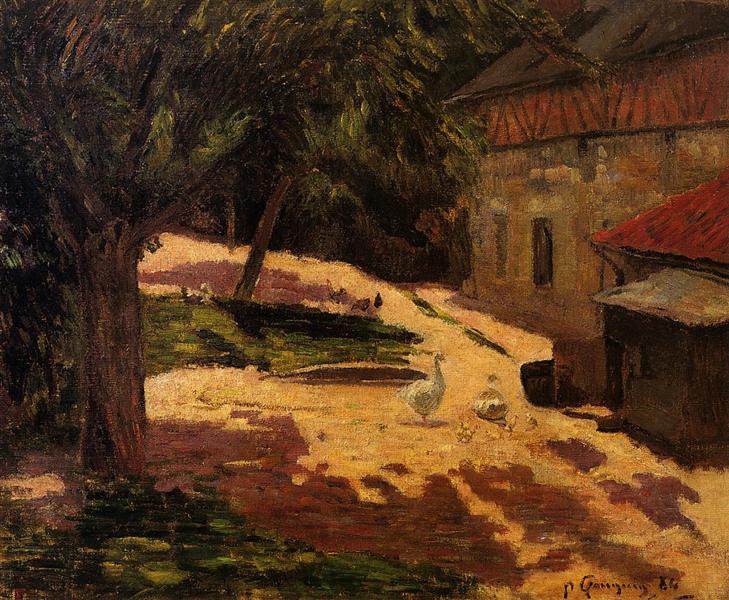Description
The work "A chicken coop" (1884) by Paul Gauguin is part of the artist's career, a period marked by his search for a new aesthetic, which would challenge the conventions of impressionism. This painting is not only a testimony of Gauguin's personal evolution, but also a reflection of his interest in rural daily life, a recurring theme in his work, in which he sought to capture the essence of simplicity and naturalism.
When observing "a chicken coop", one feels immersed in an intimate environment that evokes a feeling of tranquility. The structure of the chicken coop, with simple lines and earthly colors, is presented in a composition that, although apparently simple, has a careful balance. Brown, ocher and green tones predominate, creating a sense of harmony with the surrounding nature. This use of color, which seems almost monotonous on its surface, suggests an underlying emotional character, a distinctive feature of Gauguin's style, who frequently used unnatural colors to evoke deeper sensations.
The scene may seem stripped of the human figure with the naked eye; However, the chicken coop and the chickens that inhabit it contain an implicit narrative. The representation of birds, so common and often overlooked, invites the viewer to glimpse the daily life and beauty of rural life. This interest in marginal subjects reflects one of Gauguin's fundamental premises, which was to give voice to what he considered the most authentic and pure of human experience. The chickens, with their textures and varied colors, add a vibrant vitality to the work, and their movements suggest a life that bullets in space.
Gauguin, who had distanced himself from academic norms and impressionism, began to explore a more symbolist approach. In this sense, "a chicken coop" can be analyzed not only as a naturalistic representation, but also as a statement on the relationship of the human being with the natural environment. The work invites the spectator to consider its own connection with nature, promoting a reflection on what a rural space means.
The work is contextualized within the development of symbolism, a movement that reacted against the objective representation of the world and sought to express abstract ideas and complex emotions through symbols. Although "a chicken coop" may seem less enigmatic than other more iconographic compositions of Gauguin, she maintains the search spirit that characterizes her subsequent work, in which the elements of nature were treated with an almost spiritual approach, revealing a deeper connection between the human being and its surroundings.
In conclusion, "a chicken coop" by Paul Gauguin is a work that, through its careful composition and its use of color, addresses the theme of rural life with an emotional and reflective look. Despite its apparent simplicity, painting encapsulates the philosophy of the artist and his desire to find meaning in everyday life, an aspect that would mark the future of his work in later years. This work reminds us that, in the observation of the simple, we can find the extraordinary.
KUADROS ©, a famous paint on your wall.
Hand-made oil painting reproductions, with the quality of professional artists and the distinctive seal of KUADROS ©.
Reproduction service paintings With a guarantee of satisfaction. If you are not completely satisfied with the replica of your painting, we refund your money 100%.

